The Captain and Western Australian salty SEADOG Nick Davys go deep to discover the family history of the Formula 233.
Ah, the Formula 233. It’s the undisputed hero hull on Australian seas. It’s the most copied, most admired and most spoken-about hull on Facebook and at boat ramps. Don Aronow and his mates clearly got it right in the 1960s, building a high-performance powerboat that proved an instant winner on the racing circuit. More than 50 years later, the DNA of the Formula 233 hull design can be found in many reputable boatbuilding yards around Australia – and some not so reputable, as well.
But what happened in between the original design and today, at least on Australian shores? The Captain has scoured every internet forum and called every builder, shipwright and old salt he knows to come up with the Formula family tree. He also got some help from Nick Davys, chief of Tidal Marine & Co. and captain of the Facebook group Australian Old School Trailer Boats. We reckon Nick goes all right – and we like his Facebook page. Thankfully he hasn’t banned The Captain’s crew yet…
1960s: A LEGEND IS BORN
The 23ft 3in hull was born out of American powerboat racing. In the early 1960s, property developer Don Aronow’s drug of choice was powerboat racing and the need for speed was what rocked his boat. So the Don decided to build a really fast boat.
Don’s “formula” for success was to bring together the best in the business – designers, boatbuilders and riggers – hence the name. He hired a team of gun designers including Jim Wynne (race boat driver, naval architect and inventor of the sterndrive) and his partner, Walt Walters.
The first boat to wear the Formula name was a 233 called Cigarette after a famous rum-running boat. The boat (and hull) was a winner, launching a tidal wave of successful boating ventures including Magnum, Donzi and Cigarette (not to be confused with the original Formula boat). They were a new breed of high-performance speedster, built for presidents, kings, sheikhs and motorracing drivers. At the top of his game, the Don did business with the US government and drug cartels – at the same time. This double life led to his murder in 1987 in Miami. Aronow’s life will be portrayed in a movie called Speed Kills, starring John Travolta. Due to be shot in Miami this year, it’s sure to get tongues wagging again.
1966: AUSTRALIAN-MADE BY THE HAINES BROTHERS
At the same time that Aronow and his team were testing the Formula in Miami, Garry and John Haines Snr were building Hunt-designed Bertrams under the commission of two businessmen based in Brisbane. Several years later, they were commissioned to build the Formula 233 and eventually were offered the rights to produce the V12, V15 and V19 as well as the Formula 233 that was built under licence to Thunderbird Marine Products in the US.
The Formula hulls were built in the Goodna factory, Queensland alongside the smaller Bertram hulls designed by Raymond C Hunt. In 1966, John Haines Snr changed the name from Bertram Boats Australia to Haines Hunter due to a competing Bertram interest (started by Arch Spooner and now known as Caribbean). The name “Haines Hunter” is a combination of the brothers’ surname and a tribute to Raymond C Hunt. It’s likely that Hunt’s designs were imprinted on the original Formula 233, but opinion is divided on just how much.
What is undisputed is that the Haines brothers raced hard and with great success in V19s, Formula 233s and the 773 designed by John. The Formula 233 found its way into the recreational boating market and in the mid ’60s you could pick up a hull for only $4400. Powered by a pair of 150HP Mercruisers fed by a 60-gallon (273L) copper tank, top speed was about 45mph (72km/h). The maximum outboard rating for the day was 220HP. Surprisingly, the hull-only weight was just over a tonne; a featherweight compared to today’s Edencraft 233 Formula and Bass Strait 24 Offshore, which tip the scales at about 1650kg. Back then, the relatively lightweight hull was built for powerboat racing and day cruising, not for commercial fishermen hauling baskets of abalone.
In 1973, John Haines Snr sold a majority shareholding in Haines Hunter to an Asian business interest and by 1980, the brothers had been forced out of business. Several of the hull moulds were eventually passed on to Yaltacraft then later acquired by Edencraft for a steal.
LATE 1980s: EDENCRAFT CLAIMS A CLASSIC
When word came through the grapevine towards the end of the ’80s that Yaltacraft were shutting the Haines Hunter factory and the moulds were up for grabs, Edencraft, then a marine service centre in Eden, NSW, jumped at the chance.
Rep Erick Hyland, who now builds WhitePointer boats, tells how it went down. “A Formula mould was sitting out the front of the factory, but the Yaltacraft bloke said it was sold and waiting to be collected. I told them the deal was off unless that Formula mould was included. It was a shit-fight, but after some argy-bargy, we got it – and most of the other popular moulds as well! Erick reckons that back then, the 233 was the flagship model, despite Haines Hunter trying to push the 243.
“John Haines saw the 243 as the company’s pin-up model,” says Erick, “so you could pick up a 233 Formula hull for about $18,000 [hull-only] and we fitted them with 200HP engines. In its early Edencraft days, the 233 was one of the top sellers alongside the V17. Typically we sold them to abalone divers who wanted a tough, commercial grade boat with a dive door.”
Edencraft went on to change hands several times, but the 233 remained a production mainstay. Design updates over the years included wider gunwales, more spacious decks, a one-piece helm (with the option of an extended helm assembly) and more underfloor storage to keep the commercial operators happy. Solid wave-breakers were introduced because the builders got sick of repairing windscreens broken by taking waves over the top. Seems the standard fit-out just wasn’t up to it!
Pods were optioned to handle big fourstrokes and the structural integrity of the boat was enhanced for commercial operations, featuring fibreglass stringer systems and foam filling. Edencraft now sits in the capable hands of Grant Maher. The new crew has wasted no time making changes with an all-new lightweight composite deck, new hard-top configuration and dash layout. The most noticeable change is the 6mm windscreen wrapped within the wheelhouse (pictured) that’s sure to get tongues wagging. The model line-up features the hardtop, a shortened windscreen model and a wavebreaker version. There’s also the option of a flooded keel.
All Edencraft boats will still follow the MSV building criteria, meaning they can go straight into survey. Perhaps the biggest change is delivery times. The Edencraft team reckons customers will only have to wait 12 to 16 weeks from the commencement date, to get heir shiny new Edencraft rig.
BASS STRAIT IS BORN
Bass Strait Boats started building the 24 Offshore variant of the Formula in 1998. The “straiter” was shaped by Greg Salmond after a six-year stint at Edencraft. He reckoned he could build a more user-friendly fishing boat, adding length and width and a “variable dead-rise chine” based on a Haines signature. The chine, Greg says, helps with a drier and softer ride, and adds buoyancy to the hull.
The hull also features a planing plank for low-speed efficiency. He added a wheelhouse and flooding keel option. The Captain tested this configuration at last year’s Battle of the Big Vee, giving it two thumbs up for stability and wet-weather performance. In fact, the wheelhouse changed the perception of a few wavebreaker and runabout fans, and Greg says the wheelhouse option is now all the rage. The ride wasn’t as sleek as the narrower, round-bilged Edencraft, but it wasn’t far behind and every bit the Formula ride we’d come to recognise.
Seventeen years and about 70 boats later, Greg has crafted a new computer-cut design for the Offshore 24. It’s even longer (an extra 100mm to 7.6m) and 120mm wider at the water-line than his original Bass Strait 24 – the extra waterline beam adding to stability. It’s a full composite construction and there’s more room in the engine well, a slight change in the chines and updates to the windscreen. The first of the 7.6 models will feature a single V8 Yanmar diesel. Not surprisingly, Greg has 18 months’ worth of pre orders!
Half of Greg’s customers are commercial – from abalone divers to Police, Fisheries and Coast Guard – and the other half are serious fishermen. He even built a deck for a parasailing operation. Greg’s other notable boat is a 30-footer – not an extended 24, but a full-scale, blown-up Formula. He’s built seven, mostly for charter operators, two with outboards and the rest diesel. Internal volume is so large Greg can fit a single diesel under the floor. The ride is said to be nek level. We wonder what Don Aronow and the Yanks would think of this beast?
Footnote: the Bass Strait Boats 6m Offshore model is built by Ben Toseland in a separate factory south of Bairnsdale, Victoria. Ben used to be an apprentice at Greg’s before going out on his own. The boys still share ideas, materials and a beer.
CAM STRACHAN CASHES IN
Necessity is the mother of invention and Cam Strachan put this into practice in the late 1970s, building his own Formula variant for commercial operation as well as privateers. Payload was the priority so the original hull was split down the middle and widened about 50mm, with extra-wide chines based off a V19 added to keep the boat stable and upright in big seas. Pods were also added to give the boat more volume and to keep twin motors up and out of the water.
Cam proudly boasts of bringing home 1.7 tonne of abalone from Tasmania in huge trailing seas. His abalone catching abilities caught the attention of Fisheries and he was busted for poaching, serving several stints in the clink. In testimony to his boatbuilding skills, the Tasmanian Water Police confiscated his boat and put it into service.
In The Captain’s opinion – and much to Cam’s chagrin – we reckon his Formula rides harder than some of the sleeker versions. Extra beam, weight and larger chines will do that. But as a commercial workhorse, the cubes on Cam’s rig can’t be beaten. Secondhand models occasionally hit the market, but unfortunately this model is no longer built. Cam makes no apologies; he considers the Formula as “tiller-steer technology” compared to the boats he builds now, which feature a 30-degree monohedron design – essentially a consistent dead-rise running all the way along the hull – without any strakes. Yikes!
BEST OF THE WEST: RANGER AND MARKO SAMBRAILO
In the mid ’70s, Ranger Boats took a mould from a Formula Thunderbird. The Ranger featured a cabin cruiser model with a set-back helm position and fly-bridge, which proved too heavy up top despite being counterweighted with lead in the keel. The Ranger-built Formula models only hung around for about a decade and old models can be found starting from $10K. Also from Western Australia, Marko
Sambrailo created a stylish console from what was believed to be the old Ranger mould. It had belonged to a WA farmer and wasn’t in the best condition, but that didn’t stop Marko producing about 10 boats. The Sambrailo model featured a low-profile deck design and built-in bowsprit, adding to the sweeping lines the Formula is famous for. Marko had a reputation for building solid boats, and fisherman and west coast daytrippers typically pay around $40K to $50K for a second-hand model with motors and trailer.
VERY BEST OF THE WEST: PETER MILNER YACHTS
In the mid 1990s, Peter Milner had a vision to create a modern centre console to suit West Australian conditions. It was built to suit longrange offshore runs with big fuel capacity or to serve as a tender to larger vessels. He got his hands on a 233 mould, built a hull (which then became the plug), flipped it over and cut through either side of the keel, replacing the round bilge keel with a 260mm-wide planing pad (plank). He then removed the trademark wedges. A mould was also created for a glass stringer system along with a new console deck.
It was around this time that the Australian dollar dropped and a flood of American consoles hit our shores. A full one-piece floor liner was added, pods were trialed and later the transom was extended with built-in platforms to accommodate singles or twins. The hull length was now 7.6m and the weight came in at 1500kg, about 400kg more than an original Haines 233 Formula and just shy of the east coast cousins. The centre console was pleasing to the eye and functional. It was full volume with plenty of dry storage, room for a toilet below and 450L fuel capacity – a big ask in a centre-console configuration.
The hulls proved popular. So much so that a cabin was added to counter the infamous Fremantle Doctor. These southeast trade winds run up the coast from the Arctic during summer, bringing large swells and horrible, short, sharp chop. The cabin configuration worked beautifully, the planing plank complementing the heavier cabin configuration. It rode a little harder than the round-bilged Formula design, but the higher transition meant less wetted surface area, lower revs, better fuel consumption and lower horsepower hanging off the back. Oh, and the missus, protected in the cabin, now approved of long fishing runs!
About 45 Formula boats were built by Peter Milner Yachts and 95 per cent of those remain on the west coast. You’ll often see one or two models mooching around Rottnest and surrounding islands on the weekend. Second-hand models start around the $60K mark. They’re still in production and a facelift to the centre console model is expected later this year.
RESTORING YOUR OWN 233 FORMULA
Who hasn’t been inspired to rebuild a Formula? Before you jump on Gumtree and reach for the pinch bar, here’s some sage advice from Nick Davys.
As each year passes it becomes harder to find the perfect project. I scout the oldschool forums and groups on the internet, but the best tactic is to keep my eyes peeled around farms, industrial areas and seaside towns.
There are a few hull options (see previous pages), but the original Formula Thunderbird is the granddaddy of them all. The Haines Hunter variant has plenty of cool factor, and the Edencraft 233 and Bass Strait Offshore 24 would be epic boats to own and build, but in reality there are few bargains in these latter models and they’re not exactly ripe for a rebuild. There are some dark horses such as the WA-built PMY24 that represent good value.
Second-hand hull prices fluctuate wildly between $6K and $35K, but personally I wouldn’t pay over $12K for an old Formula hull. At this point you should probably start a list of must-haves before you start blowing the kids’ inheritance.
Once you’ve got the dream hull you’ll need gel-coat, paint, internal refit or rebuild materials, fit-out, motors and a decent trailer. You’ll need a decent tow rig, too. Other than money, you’ll need plenty of time. That’s the biggest killer of many project boat dreams, but it also represents the opportunity for the canny buyer – finishing someone else’s dream boat! With the hull in the driveway you’ll typically block the hull up off the trailer. The last thing you want to do is put a twist in her or hook the bottom of the hull. This is a matter of setting her straight, levelling her up and running your eye over her chocking the keel, transom and chines.
Now it’s time to get itchy. One option growing in popularity is fibreglass top-hat stringers, foam core internals and foam filled hulls. Using vinylester resin, stitch cloths and foam core internals could set you back about $10K. While costly, the benefits of a full composite rebuild usually mean higher resale price due to the prevention of wood rot as well as lightweight hull characteristics. A cheaper way would be to use marine ply, polyester resin, chop-strand mat and woven rovings. This would set you back about $6K in materials.
On top of that you’re going to have labour time, either your own, a handy mate or a professional to steer you in the right direction. That’s more bucks – and time spent away from your paying job, not to mention your family. Spend some serious time considering weight distribution – fuel tanks, water tanks, ballast tanks and flood chambers. If you get this wrong, you can quickly turn a legend into a nightmare.
Due to the convex hull shape and deep vee design, a 233 Formula requires decent horsepower to get the hull going. I reckon the inboard option is underrated; interesting, given they were originally designed that way. Twin-rig outboards are the most popular option, but single outboards from 250HP will do the job. Pods or transom-mounted outboards seem to be a hot topic. A pod running engines with the correct set-up can work, although you should consider the internal layout so the longitudinal centre of gravity isn’t disturbed. I prefer transom mounts. Trim tabs can help keep the nose down and with lateral stability – but learn how to operate them as its easy to come unstuck if you don’t know what you’re doing. They don’t have a reputation as a “driver’s boat’ for nothing!
One thing you’ll definitely need is proficiency around power tools. I always remind myself to measure twice and cut once to avoid costly mistakes. If you’re not good on the tools, get a qualified boatbuilder to help. Anyone can fibreglass, but attention to detail and how you use your materials makes a difference. Most of all enjoy the process. If you’re not a boatbuilder, it’s likely you’ll only do it the once!
YEAH, I GOT ONE
Grub, aka Brandon Cole, joined the Formula fan club when his dad bought an original Thunderbird Formula 233 in 1993. We gave Grub a call to find out what all the Formula fuss is about.
Hey Brandon, nice rig. Why a Formula 233?
Well, Dad had an interest in Formulas and picked up the hull about 25 years ago. It sat around for a while then he fitted fibreglass stringers and a stepped-up pod to maximise cockpit space. John McQuarrie built it and back then a couple of 150 Yammie Saltwater Series sat on the back.
A man ahead of his time, eh? Where did the boat come from?
It was owned by an ab diver out of Port Campbell – it used to be called Red Quarrells – and was painted orange, then went to red in 1998. Now it’s bright orange again, and called Awabi, which is Japanese for abalone.
That colour looks pretty epic.
Yeah, it was sprayed by John McQuarrie. Mum would never let Dad paint it that colour, but unfortunately he passed away from cancer in 2013 and I guess she’s relaxed her opinion a bit. Mum and my brothers, Jarron and Travis, got to work organising the new paint, as well as a new wave-breaker, flat-back transom and stainless bimini by McQuarrie.
Dad would be proud.
Yeah, we had the driver’s seat embroidered with: “Max – Gone Fishing” as a tribute to him.
Nice touch. Tell us about the bolt-ons.
It’s got a Furuno 685 with 1kw transducer and two 150HP four-stroke Mercs fitted by Marc Durham from The Marine Shop in Melton. It’s doing some very impressive numbers – we burned a litre per mile (combined) on a recent run to King Island. It’s rolling on a galvanized Easytow trailer.
What are you chasing?
Crays around the lighthouse, mainly as well as barrels, sharks and snapper. Now the boat’s up to scratch, I want to bring a huge
swordfish on board.
What’s the best feature about your Formula?
The ride… and the fuel economy with the new Mercury four-strokes.
Worst?
No dive door. Trying to bring big fish over the side is a mission. Everyone recognises us, too. It’s hard to hide in a big, brightorange boat.
True dat. 207kg of bronzie coming over the gunwales also turns heads. Would you ever sell her?
Nope, I don’t think there’s anything as good around. Maybe an Edencraft Formula, but it wouldn’t have the same sentimental value.
We hear ya, Brandon. The Captain salutes you – as we’re sure your Dad would.
THEN & NOW: BY THE NUMBERS
How times have changed for the Formula 233. We’ve compared the first known test of an Australian production Formula built by the Haines brothers, to the most recently tested Edencraft 233 Formula – the rig that featured in The Captain’s Battle of the Big Vee, owned by Matt Webb.
FORMULA FANG
The old twin Mercruisers on the Haines Formula hold pace with the Suzuki powered Edencraft over the first 10 seconds, then max out at about 4400RPMs, travelling at 72 km/h. The twin Suzukis on the Edencraft keep giving all the way through to 6000RPMs, travelling at 88 km/h – all while pushing about 50% extra weight.
ONE HELL OF A HULL: HOW THEY GOT IT SO RIGHT
Nick Davys on the defining characteristics of the original Formula hull. There is no part of a vessel more misunderstood than the running surface of a hull. Water is heavy stuff and can be unpredictable – just a cubic foot of water weighs 28kg. The wave is changing speed, direction and shape while the water on the surface of the wave is forming its shape with the wind. The hull is consistently changing speed and direction in relation to the sea. A fearless racer with fishing boat pedigree, Don Aronow knew the ocean better than most. With Jim Wynne and Walters they created the Formula 233 – born to take on the likes of the Bertram designed by Raymond C Hunt. Here’s how they did it…
Length: 23 foot 3 inches in length and 8 foot across the beam.
Entry angles: 62-degrees at the forefoot, running through a variable dead-rise to midships, then to a dead-rise of 24-degrees at the transom. The convex running surface of this hull (banana shape) allows the Formula to run higher with less wetted running surface below the waterline.
Flare: The stylish flare rising up from the sharp entry guides walls of blue water out and away. The dramatic look is accentuated by the upward raking chine line and the famous droopy nose.
Chine: Designed to give the boat lift and lateral stability, the chines are a convex design, reducing wetted hull surface meaning less drag and better fuel consumption. The chines aren’t as wide as some of today’s variations as she was designed to be a narrow-beamed ocean racer.
Strake: Two strakes on port and starboard are sharp and pronounced. They aid in lift and directional stability, particularly in hard turns. One strake runs the full hull length and the other three quarters of the way.
Built-in tabs: Due to the convex running surface of the hull, wedges or “hooks” were added to the original Formula design. They are about 200mm long and 300mm wide and faired in between the chine and first strake in each corner of the transom. They are designed to give the hull a bow-down attitude while accelerating on to the plane. This was especially important because the heavier inboards and outboards didn’t produce the torque and power of today’s engines.
- EPSON scanner image


























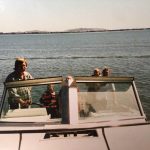

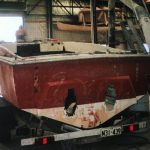




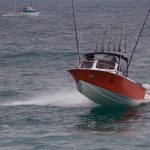












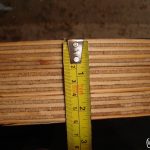




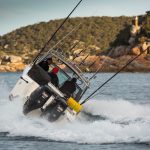





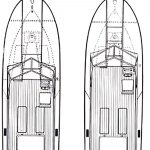




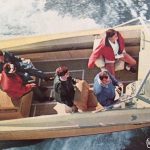
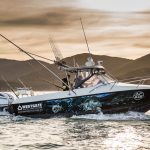



















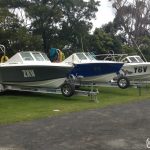







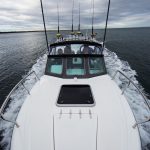









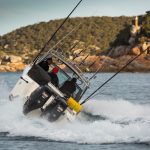








Recent Comments